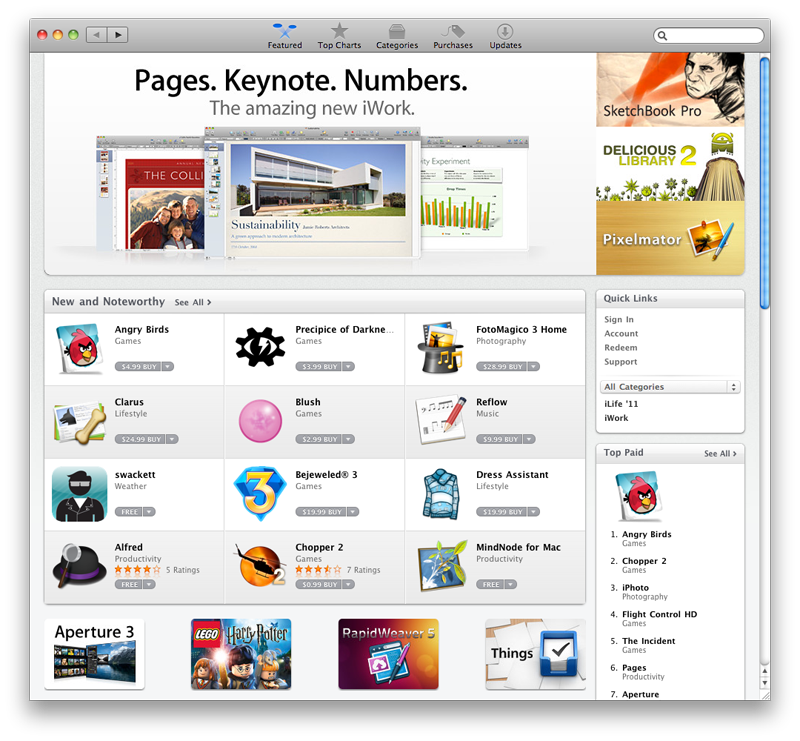Mac App Store was launched on January 6, 2011, as part of the free Mac OS X 10.6.6 update for all current Snow Leopard users. After 24 hours of release, Apple announced that there were over one million downloads. On June 4, 2018, Apple announced that a new version of the App Store. Music, TV, and podcasts take center stage. ITunes forever changed the way people experienced.
Apple didn’t introduce the App Store into Mac OS X until Snow Leopard 10.6.6. Here’s what you need to do to get the App Store. You can find out what OS X version you are on by clicking on the Apple icon, then select “About This Mac”. The number under the Apple logo is the version you are on. 10.5.x is Leopard and 10.6.x is Snow Leopard.
If you are on Leopard:
You first need to upgrade to Snow Leopard. You can find out how to do that at my “How to upgrade from Leopard (10.5) to Snow Leopard (10.6)” post. Once you do that, come back to this post and follow the instructions below.

If you are on Snow Leopard:
1. First click on the Apple icon in the top left corner of your screen. If you see the “App Store…” menu item then you can stop here, you already have the App Store.
2. If you don’t have the “App Store…” menu item then click on the “Software Update…” menu item.
3. This will launch the Software Update dialog. Once the dialog completely loads, look for an item called “Mac OS X Update Combined”. That is the OS X update that includes the App Store, so go ahead and install that. It took about 30 minutes for me.
4. After the install is complete click on the Apple icon in the top left corner of your screen. You should now see the “App Store…” menu item. If you don’t then repeat steps 2 and 3 above until you do. If you still don’t see it then just give Apple a call at 1-800-MY-APPLE (1-800-692-7753) or stop by your nearest Apple store.
If you want to see what version you currently have installed then click the Apple icon then click the “About This Mac” menu item. That will pop up a dialog like the one below. The number below the Apple icon is the version number of the Mac OS X you have installed. Like I mentioned above, it must be 10.6.6 in order to get the App Store.
Jon
Check compatibility
You can upgrade to OS X El Capitan from OS X Snow Leopard or later on any of the following Mac models. Your Mac also needs at least 2GB of memory and 8.8GB of available storage space.
MacBook introduced in 2009 or later, plus MacBook (13-inch, Aluminum, Late 2008)
MacBook Air introduced in late 2008 or later
MacBook Pro introduced in mid 2007 or later
Mac mini introduced in early 2009 or later
iMac introduced in mid 2007 or later
Mac Pro introduced in early 2008 or later
Xserve models introduced in early 2009
To find your Mac model, memory, storage space, and macOS version, choose About This Mac from the Apple menu . If your Mac isn't compatible with OS X El Capitan, the installer will let you know.
Make a backup
Before installing any upgrade, it’s a good idea to back up your Mac. Time Machine makes it simple, and other backup methods are also available. Learn how to back up your Mac.
Get connected
Mac Os 10.6 Dmg
It takes time to download and install OS X, so make sure that you have a reliable Internet connection. If you're using a Mac notebook computer, plug it into AC power.
Download OS X El Capitan
For the strongest security and latest features, find out whether you can upgrade to macOS Catalina, the latest version of macOS.
If you still need OS X El Capitan, use this link: Download OS X El Capitan. A file named InstallMacOSX.dmg will download to your Mac.
Install the macOS installer
Double-click the downloaded file to open a window showing its contents. Then double-click the file within, named InstallMacOSX.pkg.
Follow the onscreen instructions, which will guide you through the steps necessary to install.
Begin installation
After installation of the installer is complete, open the Applications folder on your Mac, then double-click the file named Install OS X El Capitan.
Click Continue and follow the onscreen instructions. You might find it easiest to begin installation in the evening so that it can complete overnight, if needed.
Mac Os 9 Download
Allow installation to complete
Please allow installation to complete without putting your Mac to sleep or closing its lid. Your Mac might restart, show a progress bar, or show a blank screen several times as it installs both OS X and related updates to your Mac firmware.
Learn more
- OS X El Capitan won't install on top of a later version of macOS, but you can erase your disk first or install on another disk.
- You can use macOS Recovery to reinstall macOS.
